
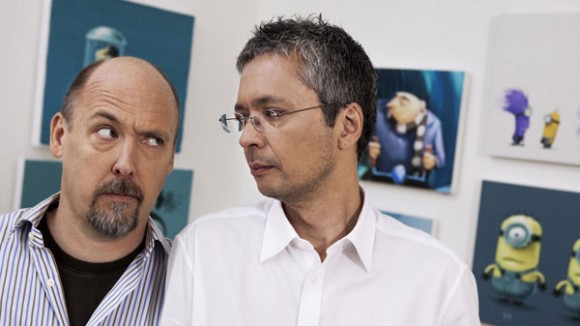
Directors Chris Renaud and Pierre Coffin on Creative Choices and Challenges in “Despicable Me” Films
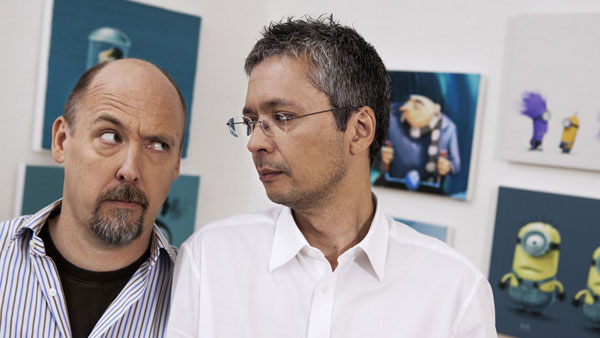
Chris Renaud (above, left) and Pierre Coffin are the directorial duo responsible for one of the biggest animated phenomenons of recent years, Illumination Entertainment’s Despicable Me franchise. And while Illumination and the film’s producer, Chris Meledandri, are based in Los Angeles, the American-born Renaud and Frenchman Coffin both work out of the Paris-based visual effects house Mac Guff, where the animation for the films is produced.
They split responsibilities pretty evenly, with Renaud, a story artist who worked on Ice Age: The Meltdown and Robots for Blue Sky, supervising the story department, and animator Coffin, a Gobelins-trained veteran who has worked at Amblimation and Passion Pictures, leading the animation team.  Cartoon Brew recently had the opportunity to speak with both of them about the origins of the Despicable Me franchise, its unconventional production pipeline, and their personal philosophies behind the work of directing animated films.
Cartoon Brew recently had the opportunity to speak with both of them about the origins of the Despicable Me franchise, its unconventional production pipeline, and their personal philosophies behind the work of directing animated films.
(Spoilers follow.)
Cartoon Brew: While Illumination is based in Los Angeles, and the animation is produced in Paris, your storyboard team is primarily freelancers working remotely. How did this arrangement come about?
Chris Renaud: When I left Blue Sky and went to Illumination, the discussion was, ‘Well, how do we do this?’ And very quickly Chris Melendandri partnered with a man named Jacques Bled (current CEO of Illumination Mac Guff) and Pierre Coffin, my directing partner with the company here in France, to get the first Despicable Me made. But we had to storyboard it first, so we looked for talent, knowing that there were great people in the United States who had a lot of experience. We had some guys who had worked on Family Guy and some that had contributed to The Simpsons, and so with a range of people we tried to build the team.
As much as pitching boards is fun, I do think that sometimes it can be misleading because you are pulled in by the pitch of this very charismatic, funny storyboard artist, and then when you put the drawings into edit, you’re like, ‘My god, this doesn’t work’. So, the remote thing has been helpful in knowing if we have something that works sooner rather than later, because you can take the drawings and get a sense of what you’ve got by just flipping through them.
Cartoon Brew: How much suggestion of a character’s performance do you get out of the storyboard process?
Chris Renaud: There are some storyboard artists who are so good with their performance in the boards that it really helps the playability of the reels. And I do think you can get suggestions of performance out of storyboards. That said, I don’t think everybody is as good at it; it’s just like animators, some guys are good at action staging – there’s a couple of the guys that are just so funny, you really can get a suggestion of performance. One of our guys, Eric Favela, who was just nominated for an individual achievement award at the Annies for boarding, is one of those guys. So, there are some guys that can really nail that. To me, if you can get your movie working as a story reel – a bunch of crude drawings – that is such an indication you are on the right track.
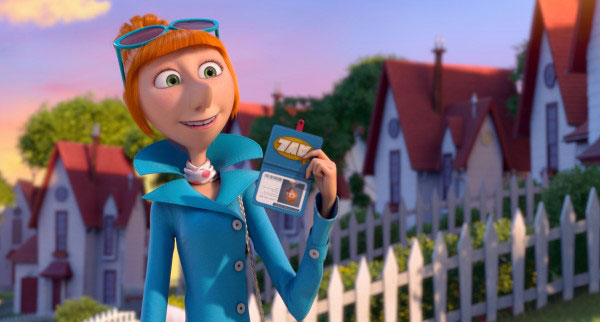
Cartoon Brew: How do you approach a scene once it is ready to go into production?
Pierre Coffin: Every time I get an individual shot, I try to put an idea in the shot. Whether it be a directorial camera idea, staging idea or animated idea, I try to push everyone in each department to find that idea that will make us if not original, at least interesting. When I see a lot of movies, animated or real-life ones, I’m always bewildered by the lack of ideas just on simple dialogue, like: shot-countershot-shot-countershot, but I try to find an idea out of these shots like, maybe the character is saying something but is more interested in that coffee cup she’s holding.
And the weight I’m putting on the animation team is to go beyond the cliché, and I’m going to cite one just because it annoys me: when you see a character who’s embarrassed rubbing his neck or rubbing his arm. You don’t want to go there; you want to go for that thing that the other guy won’t be thinking about, expressing that same idea of impatience or nervousness or agitation. You want to aim for that little human physical reaction that you’ve not seen before, but that you’ve unconsciously done that tells you that this character that you’re looking at is actually living with real emotions.
Cartoon Brew: When you start seeing clichés in the work, how do you communicate that to your animation artists?
Pierre Coffin: I tell them, ‘It’s crap.’ [laughter] ‘It’s a cliché. Find me something else.’
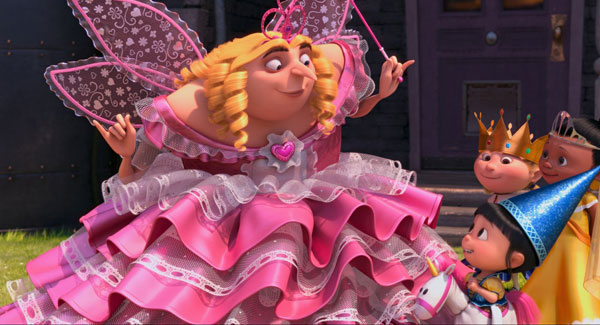
According to Renaud, the original concept for Despicable Me came from Sergio Pablos, the former Disney animator who now runs his own studio in Spain. Pablos brought the idea to Chris Meledandri, who presented it to Coffin and Renaud. However, the main character in the original pitch was a little different than the version that ended up on the screen.
Pierre Coffin: When Chris Meledandri pitched me the idea of Despicable Me, the character of Gru was way meaner than he actually is in the movie. He was really evil and he became very good and I could see the arc. When we were geared towards something where the only mean deed he does was pop a kid’s balloon at the beginning of the movie, then I started having strong doubts about whether this was going to be a good movie or if people were going to pan it. It sort of off-put me in a way. But then we found ideas to make him, in his acting, evil but very charming, so I guess in the end it turned out to be a positive.
Chris Renaud: Sergio’s character was gothic, although he had the trappings of other things; he sort of looked like Dracula and he had these big, hulking, ogre-like henchmen. As a departure from the original pitch, we sort of went into the world of James Bond, thinking of characters like Goldfinger and obviously the Bond-ian world of technology.
In the second film, we found our groove in who the character was, but in the first one, we did have to work a little bit. There were a couple of jokes that we made that were a little too far and took us too long to recover from; there was a joke at one point that – he didn’t do it, but he suggested to his neighbor that maybe he had killed the neighbor’s dog. There was a whiff of suggestion, because he was handling a bag that was actually filled with dog poop, but the suggestion was it might be the dog’s body. You could feel it, with the test audience; you could just feel the wind being sucked out of it, so we got rid of that.
Pierre Coffin: [For the sequel] they pitched me the main character falling in love and eventually marrying at the end, and I just plainly hated the idea. I don’t know if that’s my European cynical side. They said that, ‘We’ll try it out with the marriage and once we get the marriage working, we’ll try to find other ways to do it without having a marriage,’ so they did make the effort of doing it our way—Chris and mine—of trying to not have the marriage and not to have this very corny ending.
So, the way I approached the wedding is very tongue-in-cheek, third degree, everything is pushed to the limit of ‘we’re making a joke out of this.’ We have this very emotional moment of the girl standing up on the table; we don’t want to break that, but all the rest is like, ‘Okay, this is not serious.’ When we did the first previews, the marriage was working very well with the public and all of our alternate endings, very objectively, didn’t work. Trying to find ideas around the big [wedding] idea that I didn’t like just made it somehow successful.

Cartoon Brew: What was the decision behind turning the minions from the “ogre-like” characters in the original pitch to the versions you see in the final film?
Chris Renaud: I guess it was an appeal issue for Gru. We kept finding that the sillier it was, the better it was. So the minions, as these sort of child-like, irresponsible characters sort of help Gru’s appeal. They all love him the way that children unequivocally, without question, love their parents. And so it instantly gave him some likeability because these little guys liked him.
A lot our influence comes from the old Warner Bros. cartoons of the Bugs Bunny tradition. I still watch those with my kids and they’re still some of the funniest cartoons ever done. We like to think that that, as well as the design [of the minions], a lot of which was done by Eric Guillon (below), is taking advantage of what animation does best. Even though they’re not speaking any language that anyone knows, they have this kind of broad appeal.
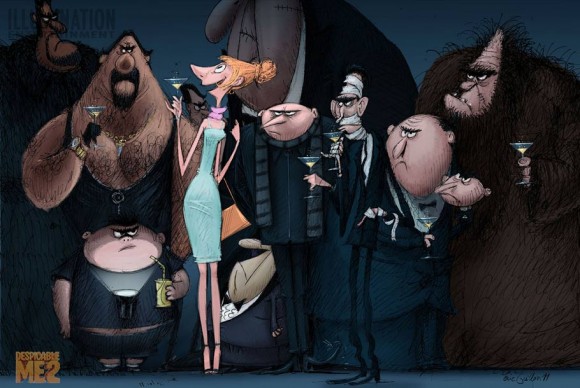
Chris Renaud: We try in our CG, even the designs, to be very graphic and very stylized, harkening back to that 2D feel. We try not to go real; both Pierre and I are very against that, to be honest. And I always say that a drawing is inherently funny and appealing, but computer animation is inherently unfunny and unappealing, because you have to pull it out of a computer. It’s so methodical; the spontaneity of a drawing is what you’re trying to land. That life and spontaneity.
Cartoon Brew: Some of the budgets of other American studio films are almost two to three times what you’re working with on these films, yet the quality is just as good, if not better. How do you maintain quality on a fraction of the budget?
Chris Renaud: I think at the end of the day, it boils down to time. I think it comes from working with Chris Meledandri and Janet Healy, and our writers and Pierre and I, we’re all in agreement about the movie we’re making so the movie doesn’t have an opportunity to go off in one direction and everyone’s sort of like, “Whoa!,” after three months. Everyone stays in touch with each other and we’re all sort of rowing in the same direction. And I think that, at the end of the day, that translates into the ability to make the movie in 2-2½ years from start to finish. Some of the other studio films you’re referring to, some of them have been around as long as 8-10 years and that costs.
Cartoon Brew: Does that leave room for collaboration and new ideas from members of your team along the way?
Chris Renaud: As a director, and this is just my personal philosophy, one of your jobs is to recognize an idea better than your own and move out of the way of that better idea. We’ll look at a scene, and we’re like, ‘We recognize that it’s doing it’s job narratively but there’s no idea behind it.’ For instance, like the scene where Gru is trying to find the PX-41 and he has that sensor on his belt buckle: the storyboard artist pitched the idea of him doing the suggestive gesturing as he’s looking in the wig shop. And we were like “Ok!,” but before we had that it was just a scene. And we always have to push ourselves to find that idea that’s going to make it unexpected and fresh and make an audience want to watch it.

Pierre Coffin: I thought Despicable Me was going to fail when it came out, and when they pitched me Despicable Me 2, I thought it was going to fail also, and we’re working on the Minion movie right now, and my guess is that everybody will think that we’re doing it because we know that they are marketable, and that the movie will be a hit, but I just don’t work that way. This may sound very corny, but I don’t want to make a crappy movie.
Cartoon Brew: Is thinking that the films won’t do well just a self-deprecating reaction to how immmensely successful they’ve been?
Pierre Coffin: It could be. It could be self-preservation also, and it feels like it’s something that keeps me going in trying to make the movie better than what it initially is. The whole team has been working with me since DM1 and it’s harder on us just because we have the tendency to go to the same well, and we have to find ideas that we haven’t explored before.

.png)